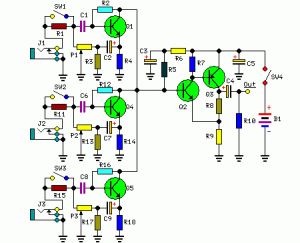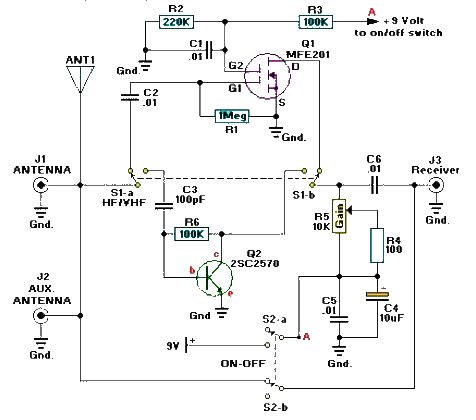
Active mixer and 180 degrees

A simple active mixer is desired to be placed in front of a power amplifier. Research has been conducted on active operational amplifier (op-amp) mixers, which provide various insights.
An active mixer utilizing operational amplifiers (op-amps) is an essential circuit for audio applications, enabling the combination of multiple audio signals into a single output while maintaining signal integrity. The design typically involves the use of multiple op-amps configured as summing amplifiers.
To construct a basic active mixer, the following components are required:
1. **Operational Amplifiers**: At least two op-amps are needed, but more can be added depending on the number of input signals. Common choices include the TL072 or LM358 due to their low noise and high performance.
2. **Resistors**: Resistors are used to set the gain of each input signal and to provide feedback in the op-amp circuit. The values of these resistors will determine the mixing ratio of the input signals.
3. **Capacitors**: These may be included for AC coupling to block DC offsets and prevent signal distortion.
4. **Power Supply**: A dual power supply (e.g., ±15V) is often required for op-amps to function correctly, ensuring that the output signal can swing both positively and negatively.
The circuit configuration typically involves connecting the output of each audio source to the inverting inputs of the op-amps through resistors. The non-inverting inputs are usually grounded. The feedback resistor from the output to the inverting input sets the gain of the mixer. The final output can be taken from the output of the op-amp.
For better performance, it is important to ensure that the op-amps used have sufficient bandwidth to handle the audio frequencies of interest, typically ranging from 20 Hz to 20 kHz. Additionally, layout considerations such as minimizing the length of signal paths and using proper grounding techniques can help reduce noise and interference.
In summary, an active mixer using op-amps is a versatile solution for combining audio signals, providing flexibility in design and the ability to achieve high-quality audio output suitable for driving a power amplifier.Hello, i want to make a simple active mixer to place in front of the power amp. I read some documents about active op-amp mixer.And they said : Any.. 🔗 External reference
An active mixer utilizing operational amplifiers (op-amps) is an essential circuit for audio applications, enabling the combination of multiple audio signals into a single output while maintaining signal integrity. The design typically involves the use of multiple op-amps configured as summing amplifiers.
To construct a basic active mixer, the following components are required:
1. **Operational Amplifiers**: At least two op-amps are needed, but more can be added depending on the number of input signals. Common choices include the TL072 or LM358 due to their low noise and high performance.
2. **Resistors**: Resistors are used to set the gain of each input signal and to provide feedback in the op-amp circuit. The values of these resistors will determine the mixing ratio of the input signals.
3. **Capacitors**: These may be included for AC coupling to block DC offsets and prevent signal distortion.
4. **Power Supply**: A dual power supply (e.g., ±15V) is often required for op-amps to function correctly, ensuring that the output signal can swing both positively and negatively.
The circuit configuration typically involves connecting the output of each audio source to the inverting inputs of the op-amps through resistors. The non-inverting inputs are usually grounded. The feedback resistor from the output to the inverting input sets the gain of the mixer. The final output can be taken from the output of the op-amp.
For better performance, it is important to ensure that the op-amps used have sufficient bandwidth to handle the audio frequencies of interest, typically ranging from 20 Hz to 20 kHz. Additionally, layout considerations such as minimizing the length of signal paths and using proper grounding techniques can help reduce noise and interference.
In summary, an active mixer using op-amps is a versatile solution for combining audio signals, providing flexibility in design and the ability to achieve high-quality audio output suitable for driving a power amplifier.Hello, i want to make a simple active mixer to place in front of the power amp. I read some documents about active op-amp mixer.And they said : Any.. 🔗 External reference





